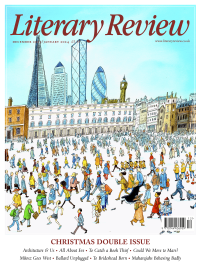Norma Clarke
Portrait of the Artist as a Young Woman
Pauline Boty: British Pop Art’s Sole Sister
By Marc Kristal
Frances Lincoln 256pp £25
In October 2013, Marc Kristal popped into Christie’s to get out of the rain and saw an exhibition called ‘When Britain Went Pop: British Pop Art – The Early Years’. His attention was caught by two paintings, one by David Hockney, with whose work he was familiar, and the other, a large mixed-media canvas from 1964 entitled It’s a Man’s World I, by an artist wholly new to him, Pauline Boty. This collage-type painting, featuring portraits of famous men from Elvis Presley to Einstein and Lenin, seemed ‘at once light-hearted and pitiless’. He also, surprisingly, judged it to be a self-portrait. His interest in the artist was piqued.
Boty graduated from Wimbledon School of Art in 1958, went on to the Royal College of Art (RCA) and was one of the few women in the British Pop Art movement of the 1960s. She can be seen alongside Peter Blake and others in Ken Russell’s 1962 BBC documentary Pop Goes the Easel. She was fresh, bold, beautiful, a feminist, full of life and cheek. ‘All over the country,’ she wrote, ‘young girls are sprouting, shouting and shaking, and if they terrify you, they mean to and they are beginning to impress the world.’ Alas Boty didn’t have long to terrify or impress. Diagnosed with leukaemia in early pregnancy, she decided to delay treatment so that her baby would survive. She died at twenty-eight in 1966. Her work disappeared. In the early 1990s, when the Barbican was planning the exhibition ‘The Sixties Art Scene in London’, Boty’s daughter took the curator, David Alan Mellor, to Kent, where the family had stored her canvases. Liking what he saw, he included some in the exhibition and in a small way a revival began.
Kristal’s book is a full-scale celebration of Boty’s life that puts her into the history of the movement. There are some surprises. It turns out that Boty began by studying stained glass, which at Wimbledon School of Art was apparently the hip thing to do, as was ‘learning

Sign Up to our newsletter
Receive free articles, highlights from the archive, news, details of prizes, and much more.@Lit_Review
Follow Literary Review on Twitter
Twitter Feed
Though Jean-Michel Basquiat was a sensation in his lifetime, it was thirty years after his death that one of his pieces fetched a record price of $110.5 million.
Stephen Smith explores the artist's starry afterlife.
Stephen Smith - Paint Fast, Die Young
Stephen Smith: Paint Fast, Die Young - Jean-Michel Basquiat: The Making of an Icon by Doug Woodham
literaryreview.co.uk
15th-century news transmission was a slow business, reliant on horses and ships. As the centuries passed, though, mass newspapers and faster transport sped things up.
John Adamson examines how this evolution changed Europe.
John Adamson - Hold the Front Page
John Adamson: Hold the Front Page - The Great Exchange: Making the News in Early Modern Europe by Joad Raymond Wren
literaryreview.co.uk
"Every page of "Killing the Dead" bursts with fresh insights and deliciously gory details. And, like all the best vampires, it’ll come back to haunt you long after you think you’re done."
✍️My review of John Blair's new book for @Lit_Review
Alexander Lee - Dead Men Walking
Alexander Lee: Dead Men Walking - Killing the Dead: Vampire Epidemics from Mesopotamia to the New World by John Blair
literaryreview.co.uk